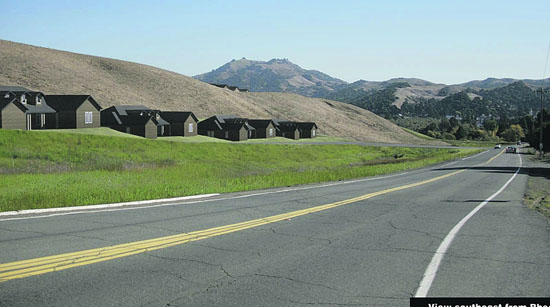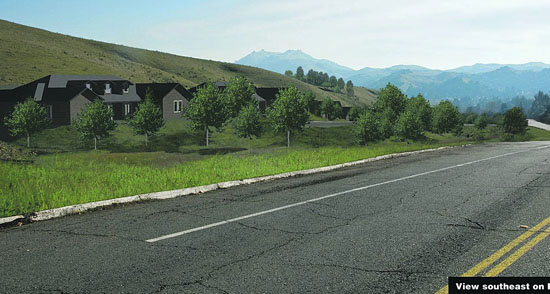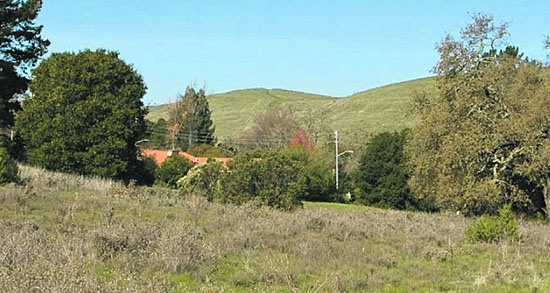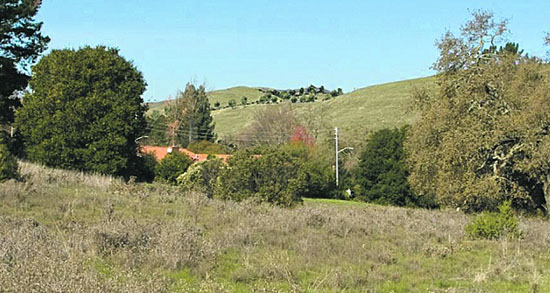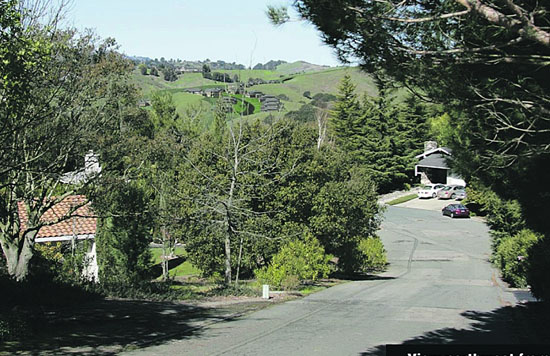 | | | Final house configuration with no trees, view northwest from Joseph Drive
Photo simulation provided by the Towns web site can be found at:
http://moraga.ca.us/production/moraga_Rancho_LagunaII.php
| | | | | | May 26th was yet another long night in Moraga. 106 people, who came to that evening's Town Council meeting to hear whether or not the Planning Commission's approval of the 27-home Rancho Laguna II project would be upheld or not, waited until past midnight to hear the Council's decision. The appeal was neither granted nor rejected. Two of the three sitting members of the Council asked staff and the applicant to produce a new version of the project that would minimize the visual impact from public roads, but did not prohibit ridgeline development.
 Malcolm Sproul summarized in one sentence what was at stake that night: "This discussion provides you with the opportunity to articulate your vision for the town," he said to Vice-Mayor Karen Mendonca, and Council Members Howard Harpham and Dave Trotter. Mayor Ken Chew and Council Member Mike Metcalf live too close to the development and had to recuse themselves. The decision hinged on the interpretation of ridgeline protection as defined in the Moraga General Plan, and the right of property owners not to be deprived of all economically viable uses of their property.
Malcolm Sproul summarized in one sentence what was at stake that night: "This discussion provides you with the opportunity to articulate your vision for the town," he said to Vice-Mayor Karen Mendonca, and Council Members Howard Harpham and Dave Trotter. Mayor Ken Chew and Council Member Mike Metcalf live too close to the development and had to recuse themselves. The decision hinged on the interpretation of ridgeline protection as defined in the Moraga General Plan, and the right of property owners not to be deprived of all economically viable uses of their property.
 Trotter agreed with the appellant that the General Plan prohibits construction on ridgelines. "I have concluded that the Rancho Laguna project, in one very important respect - it's proposal to place 12 homes on the ridgeline - is not consistent with the principles and text of the 2002 Moraga General Plan," said Trotter. He cited the prime principle of the text, which gives direction to preserve open space and undeveloped ridgelines, and cited article CD 1.5, which states, "Protect ridgelines from development." Trotter explained, "I firmly believe that one cannot 'preserve' or 'protect' undeveloped ridgelines by approving a major subdivision that allows homes to be built on this ridgeline." Instead he proposed eliminating the 12 homes slated to be built on a ridgeline and concentrate the development of the property on less environmentally sensitive areas such as along Rheem Boulevard or another part of the upper valley, if the appropriate and site-specific geotechnical findings supported such development.
Trotter agreed with the appellant that the General Plan prohibits construction on ridgelines. "I have concluded that the Rancho Laguna project, in one very important respect - it's proposal to place 12 homes on the ridgeline - is not consistent with the principles and text of the 2002 Moraga General Plan," said Trotter. He cited the prime principle of the text, which gives direction to preserve open space and undeveloped ridgelines, and cited article CD 1.5, which states, "Protect ridgelines from development." Trotter explained, "I firmly believe that one cannot 'preserve' or 'protect' undeveloped ridgelines by approving a major subdivision that allows homes to be built on this ridgeline." Instead he proposed eliminating the 12 homes slated to be built on a ridgeline and concentrate the development of the property on less environmentally sensitive areas such as along Rheem Boulevard or another part of the upper valley, if the appropriate and site-specific geotechnical findings supported such development.
 Harpham disagreed with Trotter, suggesting that the right place to start the analysis of the question was in fact with the property rights of the owner. He indicated that staff's opinion was that the proposed development was consistent with the General Plan, and that that was enough for him. He further indicated that requiring the developer to start over with new plans after years of work was not the right action to take. "We are going to set so many road blocks that in fact (the property owner) can't do it, and that's simply an injustice," said Harpham, who said that he would reject the appeal.
Harpham disagreed with Trotter, suggesting that the right place to start the analysis of the question was in fact with the property rights of the owner. He indicated that staff's opinion was that the proposed development was consistent with the General Plan, and that that was enough for him. He further indicated that requiring the developer to start over with new plans after years of work was not the right action to take. "We are going to set so many road blocks that in fact (the property owner) can't do it, and that's simply an injustice," said Harpham, who said that he would reject the appeal.
 Mendonca's interpretation of the protection of the ridgelines did not include forbidding development. "Protect versus prohibit is one of the corner stones of this debate," she said, "Protect can mean prohibit, it can mean relocate, it can mean camouflage, screen, limit." She recommended that staff and the applicant work together on a solution that would guarantee that no home could be seen from any scenic corridor and the Lafayette-Moraga Trail, "If it means moving some of the homes to the lower portion of the development (along Rheem Boulevard) that is fine with me," she said.
Mendonca's interpretation of the protection of the ridgelines did not include forbidding development. "Protect versus prohibit is one of the corner stones of this debate," she said, "Protect can mean prohibit, it can mean relocate, it can mean camouflage, screen, limit." She recommended that staff and the applicant work together on a solution that would guarantee that no home could be seen from any scenic corridor and the Lafayette-Moraga Trail, "If it means moving some of the homes to the lower portion of the development (along Rheem Boulevard) that is fine with me," she said.
 Mendonca's position surprised residents who had been supporting her. "I was very sad to see Council Member Mendoca go against the core values that she espoused so enthusiastically in her election campaign of 2008," said Frank Comprelli. "Trotter's comments were very well thought out, and Harpham didn't run on an open space platform," said Malcolm Sproul, "I am very disappointed in Mendonca's comment, the rationale she used. Ridgelines are physical topographic features with a different value." Sproul agreed with Trotter's position that a decision by the Council to allow development on a ridgeline would set a dangerous precedent in the interpretation of the General Plan.
Mendonca's position surprised residents who had been supporting her. "I was very sad to see Council Member Mendoca go against the core values that she espoused so enthusiastically in her election campaign of 2008," said Frank Comprelli. "Trotter's comments were very well thought out, and Harpham didn't run on an open space platform," said Malcolm Sproul, "I am very disappointed in Mendonca's comment, the rationale she used. Ridgelines are physical topographic features with a different value." Sproul agreed with Trotter's position that a decision by the Council to allow development on a ridgeline would set a dangerous precedent in the interpretation of the General Plan.
 Mendonca later explained, "I actively supported it (Measure K) and I wish that it had passed; unfortunately, it did not. The will of the people still speaks in Moraga, and the will of the people in the November 2008 election was not to pass Measure K. It is entirely inappropriate, unethical, and illegal for me to use the language contained in Measure K to make land use decisions for the Town of Moraga. Therefore, I must use the current language of the General Plan to guide my decisions," said Mendonca.
Mendonca later explained, "I actively supported it (Measure K) and I wish that it had passed; unfortunately, it did not. The will of the people still speaks in Moraga, and the will of the people in the November 2008 election was not to pass Measure K. It is entirely inappropriate, unethical, and illegal for me to use the language contained in Measure K to make land use decisions for the Town of Moraga. Therefore, I must use the current language of the General Plan to guide my decisions," said Mendonca.

|

